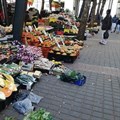The informal sector in South Africa consistently thrives. It is the unsung backbone of South Africa’s free trade, quietly serving thousands of South African households in all nine provinces.

Image supplied. Ged Nooy, GM of Field Force provides three trends that stand out in the current informal trade market
Yet, in many ways, this juggernaut of local commerce remains a missed opportunity for FMCG manufacturers that stand to reap immense benefits if they understand – and capitalise on – the sector.
Why FMCG manufacturers need to notice the informal market
FMCG manufacturers must double down on this sector, and here’s why. According to South African FMCG and retail reports, it is estimated that approximately 30% of retail sales are conducted in South Africa’s informal sector (Trade Intelligence), and depending on the product category, this figure can spike up to 50%.
Accenture Africa research shows that there are over 150,000 Spaza stores across South Africa, with 80% of the country’s population shopping at these stores daily.
Beyond that astounding number, the informal market is experiencing phenomenal growth (23% versus the formal market at 14.7% – NIQ).
There are also favourable circumstances for manufacturers, in that landing products on informal shelves is more cost-effective than the formal market, as there are no trading terms in place.
Plus, manufacturers have more influence on informal shoppers than they do on formal shoppers, given that formal retailers own the shopper relationship and messaging to shoppers more and more.
3 trends
Three trends stand out in the current informal trade market:
- Trust
Trust is becoming paramount for shoppers within the informal market, particularly when it comes to edible food products. The informal trade has been proliferated with both expired and counterfeit products that have caused poisoning and even death in children.
Interestingly, when shopping for food, shoppers like to buy food from stores where they see bread trucks making deliveries every morning, as they believe these are stores that sell goods that can be trusted.
Brands need to ensure that their product in stores is not counterfeit and not expired. There is a great opportunity to promote the health and safety features of genuine, trustworthy goods.
- Proximity, relationship
Convenience and top-up shopping make the informal market a very compelling proposition (also more cost-effective for the shopper – less travel costs etc). The store and trader have relationships with their community and shoppers, often extending them lines of credit, IOUs and discretionary discounts on price.
The shopper also assists in driving the always expanding product assortment by creating a push/pull strategy by requesting products – so, the more requests for a product there are, the more chance that the trader will stock it. Given this push and pull, brands and manufacturers need to market to local shoppers and communities to drive demand.
- Cash is King
Many fintech products and services are targeting the informal sector, and while electronic payment methods are growing (off a low base), cash remains the dominant form of payment within the sector – and cash stays within the community. Not taking this into account in your planning and understanding of the informal sector can be a costly oversight.
The immediacy of cash-in-hand and the growing needs of the market have also prompted spaza owners to expand their offerings. For example, vouchers continue to grow in popularity – from pre-paid electricity, data bundles airtime, and sports betting.
Additionally, many informal stores have set up 24-hour Wi-Fi hotspots where shoppers can purchase data vouchers and leverage the Wi-Fi from the store, ensuring that the outlet gains more relevance within its community.
Sheetal Patel and Mushambi Mutuma, Accenture in Africa 24 Jul 2023 What to focus on
We know the trends, but what should FMCG manufacturers focus on specifically?
- Understanding the shopper, the consumer and the trader
The informal trade and its shoppers (considering purchase) and consumers (who have made purchases) are different to the formal trade. With this in mind, brand messaging, pack sizes and the route to market are not a copy and paste from the formal market.
It is vital to learn and understand the shopping mission and occasion, understand who the shopper is buying for, and most importantly, understand the trader, identifying where they get their stock, how often they re-stock, who their shopper base is and whether they purchase on credit or cash.
Once this is understood – the brand can plan accordingly to market and target shoppers.
- Know your route to market and execute
Knowing where the most important trader base is procuring their stock is paramount. Wholesale remains the major point of purchase for the informal market. A compelling trader value proposition is the “key to the kingdom”, and it falls to the manufacturer to ensure that must-stock informal market SKUs are always available, in stock, on-shelf and at the correct price point.
- Support the trader
By providing product education, trader kits and loyalty support, loyalty and trust are built with the trader. To be effective, this needs to be an ongoing strategy encompassing regular communication and maintaining support. Informal trade is not a “blitz” or once-off event.
- Be visible in the communityThe community supports the informal trade, and their demand determines the store’s assortment of products. Increasing sales and gaining market share requires that the manufacturer’s brand is always present and visible in the community through targeted direct and indirect marketing, investing back into the community via sponsorships or socio-economic development.
"Everyone is doing it, so why don’t you?”
While the informal market might appear – at least at face value – to be less organised and less predictable than the formal sector, applying an understanding of the market, its shoppers and consumers can bring unprecedented awards.
Let’s not miss the golden opportunity this year to connect with the lifeblood of South Africa’s informal shopper. Possibility awaits around several corners in our streets, settlements and urban hideaways.

























